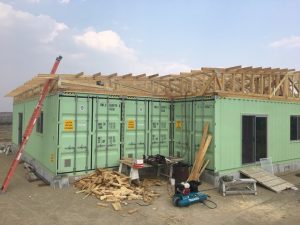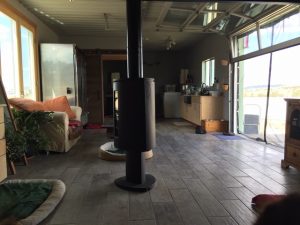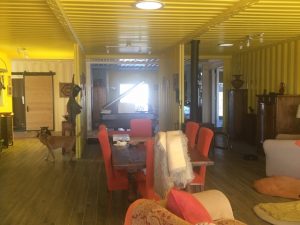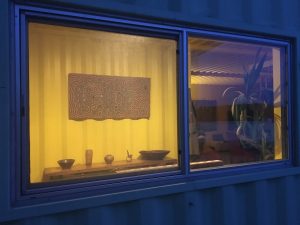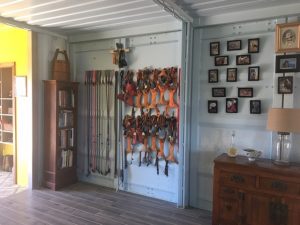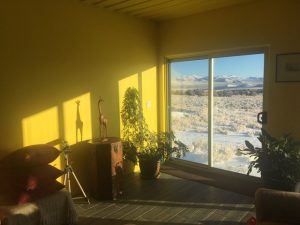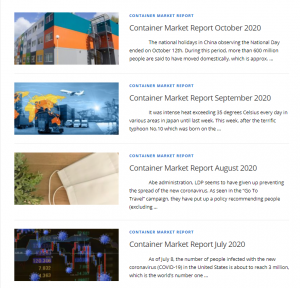 I publish the container market report in Japanese and in English every month. It has been 11 years already since I started this report. When I founded this company, I often received telephone calls asking for the container market situation. With the increasing number of such inquiry by phone, I came up with the idea of notifying our valued customers of changes in market conditions in the form of monthly container market report. Through the activities of container leasing companies, shipping lines, and container manufacturers, I aimed to inform and direct a spot light on how deeply the movement of containers is related to the world economy and politics, the container leasing market, and the movement of new and used container prices, etc.
I publish the container market report in Japanese and in English every month. It has been 11 years already since I started this report. When I founded this company, I often received telephone calls asking for the container market situation. With the increasing number of such inquiry by phone, I came up with the idea of notifying our valued customers of changes in market conditions in the form of monthly container market report. Through the activities of container leasing companies, shipping lines, and container manufacturers, I aimed to inform and direct a spot light on how deeply the movement of containers is related to the world economy and politics, the container leasing market, and the movement of new and used container prices, etc.
Another reason I decided to issue the report is that I felt the importance of the Japanese and Japan getting out of the closed culture, going out to the world, and getting people around the world to understand Japan better. I believe that the Japanese can best contribute to the world peace. This is why I thought it was necessary to appeal that we Japanese people are here. Since April 2000, the first month of publication, the container market report has been published both in Japanese and in English. However, the English version was delayed by 1-2 days. That was because I had to write the manuscript and translate the report into English as well by myself, with the quality that I am satisfied with. However, since this May, I have asked that translation work to Ms. Chizuru Oowada, who joined us and is fluent in English, and we can now send English version on the same day as Japanese report. I also feel that expression in English report has improved dramatically.
The introduction has become long, but I receive feedback on the report from many people. I receive many encouraging emails and phone calls not only from Japan but also from overseas.
Twice a year, I have participated in the Intermodal sponsored by the Container Owners Association (COA) in Shanghai and Europe since the next year EFI was established. I hope they don’t mind but I have been sending the report to those people I met there. I was so glad when a person in Rotterdam, who happened to be out of my memory, coming to me and friendly told me “I’m reading your report!”. By the way, Mr. Patrick Hicks of COA Secretariat is also one of the readers. Occasionally he sends me an email of encouragement.
The story I will introduce here is about Mr. Phil Behenna. After I met him once when I was in charge of Triton Tokyo, I met him again in Shanghai, Hamburg and Rotterdam when I attended Intermodal as EFI. In the last month’s report, I brought up the issue that Government’s permission is necessary in Japan to build houses, warehouses, shops, hotels, or villas in case of using ISO containers, and wished that it would be wonderful if we each could make a container house as we prefer. I received an email from him saying that he now lives in Nevada and his house is made of 11 new 40F Hi-cube containers.
Without hesitation, he kindly took the trouble to make an article introducing his container house to the readers of EFI’s Japanese container market report.
EF International Ltd.
Managing Director
Harumi Nakao
(translated by Chizuru Oowada)
The introduction of my container house by Mr.Phil Behenna
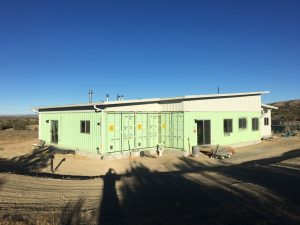 My wife and I live in a shipping container house. It is composed of 11 x 40HC and we live approximately 1800M above sea level in the NE corner of Nevada. The location is remote – the nearest small town is about 50KM away.
My wife and I live in a shipping container house. It is composed of 11 x 40HC and we live approximately 1800M above sea level in the NE corner of Nevada. The location is remote – the nearest small town is about 50KM away.
We chose to live in shipping containers for a number of reasons. 1) I have been involved in the container business during my career. 2) we believed that shipping containers would be appropriate for our location (prone to earthquake, winds and wildfire).
We bought the containers in China in 2015 and then moved them to Long Beach for their initial modification (cut-outs in walls, and openings for doors and windows). We then trucked the containers to our location (about 1000KM) and used a crane to lower them to the foundation. The order of building was as follows:
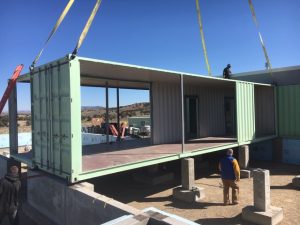 1. Perform initial modifications in Long Beach
1. Perform initial modifications in Long Beach
2. Build foundations at the site (a perimeter wall and 1.5M high pedestals to support the containers)
3. Truck the containers and lower them down onto the foundations
4. Weld the containers to each other and to the foundation
5. Build a sloping roof over the top of the containers
6. Insulate the roof and walls
7. Complete plumbing & electrical work
8. Complete the floor
9. Paint
10. Furnish and move in
1. How easy was it to build?
Not bad. It took longer than we had hoped but we live in a location where it snows and the building season was quite short each year. Our builders had not constructed a container home before so they were learning too.
2. How did you manage to meet building requirements?
We worked with our local authorities throughout the building process. They had never supervised a container home before. They were interested, but their building code of inspections had nothing in it about container homes. So at times we had to conform to irrelevant requirements. They inspected the building perhaps 15 times over the course of the process. We used a firm of structural engineers to make sure the house was built strongly.
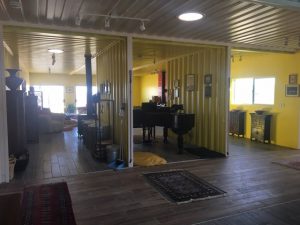 3. What are the good things about living in a container home?
3. What are the good things about living in a container home?
WIND: It feels very strong. The whole thing probably weighs 80-100 tonnes and feels solid. I think it would perform well in a hurricane, typhoon or tornado.
FIRE: And while it is not “fire proof”, I believe it would resist catching fire for much longer than a traditional wood/plywood house.
EARTHQUAKE: and by keeping the container roofs simple & unadorned, there is nothing to fall on us during an earthquake: the building might move but I believe the inhabitants would be quite safe.
NOVELTY: It feels interesting – I like looking at the container roofs and walls – I like their geometric regularity. And the fact that the walls are metal is useful – it’s easy to use magnets to hang pictures and other things.
4. What are some important considerations?
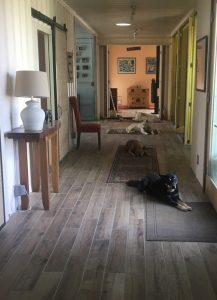 a) Insulate the container very well. We used closed cell blown polyurethane foam in the walls and on top of the container roofs in the attic. That keeps the temperature to about 25C max without A/C when it is 40C outside , and in the winter (when it can drop to -25C) to about 17C without heating.
a) Insulate the container very well. We used closed cell blown polyurethane foam in the walls and on top of the container roofs in the attic. That keeps the temperature to about 25C max without A/C when it is 40C outside , and in the winter (when it can drop to -25C) to about 17C without heating.
b) Normal wooden houses (especially Japanese houses?) breathe. They allow water vapor to move out of the building. A metal container home is much more tightly sealed. For that reason – particularly in a humid or cold environment, or where there are a lot of humans or animals breathing – you need to create ways for your building to reduce humidity (dehumidifier, opening windows, etc).
c) Shipping containers are not identical. You need to assume that there will be slight differences in the dimensions of a group of standard 40HCs for instance: they are not identical down to the last millimeter. You will notice the differences during construction.
d) If you are insulating using blown foam, you should place your electrical wiring inside metal conduit piping in the walls. That way, if an electrical cable needs replacing, it can be pulled through the pipe without having to disturb the foam.
e) It seems quite normal that during the initial stages there will be some expansion & contraction noises – it’s a bit like being on a ship!
f) if you have a lot of building space (as we did), then you can construct your home on a single level. If you lack space, it is definitely possible to stack the containers (either directly over each other, or leaving gaps) and build vertically.
5.What’s the biggest problem you’ve faced so far?
Figuring out how to get rid of moisture in the winter! There are 2 adults in our house, but a lot of dogs! That’s a lot of creatures breathing in and out. The humidity level can reach 65% indoors first thing in the morning in the bedroom and that can cause condensation to form on the inside of the windows in the winter. I’m trying to solve that problem!
Phil
■Message from Mr.Phil Behenna
I joined the container shipping industry in 1991, working for P&OCL in London, with a responsibility for aspects of equipment and trade management in the Middle East/South Asia. I moved to Rotterdam in 1994 to take over trade management for the Former Soviet Union. In 1996 I was transferred to Shanghai to fulfill the role of Owner’s Representative for P&OCL and then (after the merger with Nedlloyd) to handle aspects of IT, Customer Service and local trade management in China. In 1998-9 I moved to Hong Kong to take up the role of General Manager for the Far East, East Africa and Gulf Trades.
I joined International Asset Systems (IAS) in Hong Kong in 2000 as Vice President for Asia and then moved to the USA with them as Senior Vice President in 2001. I stayed with IAS until the end of 2013 at which point I established Container Interchange LLC (CI) with whom I have been working ever since. CI specializes in the interchange of containerized equipment between shipping operators to reduce imbalance and save costs. We work with all of the major shipping companies around the world.
My interests (other than container shipping!) include alternative and innovative housing design & alternative energy management. Our container home is fully solar powered and we operate independently of any utilities.
